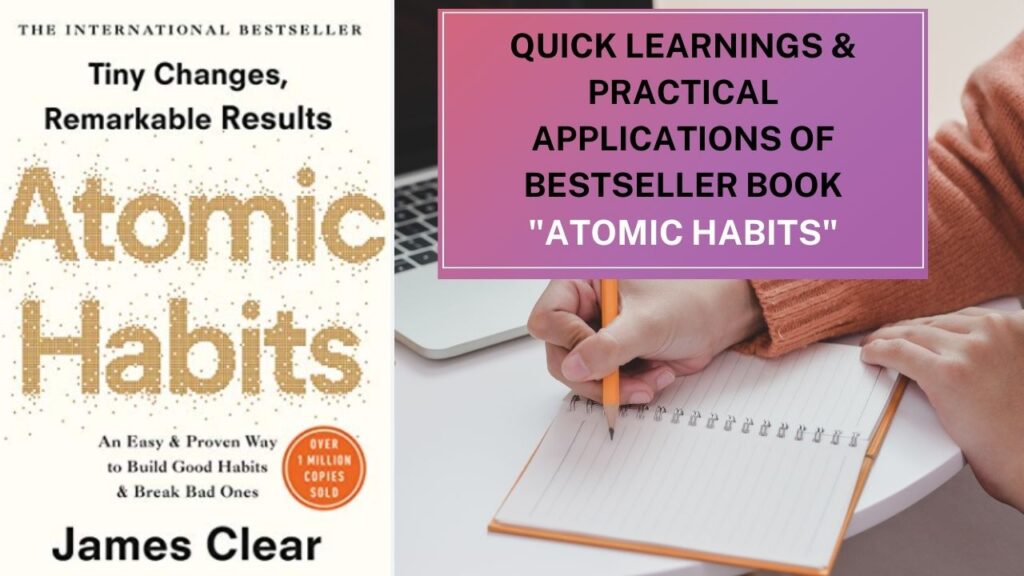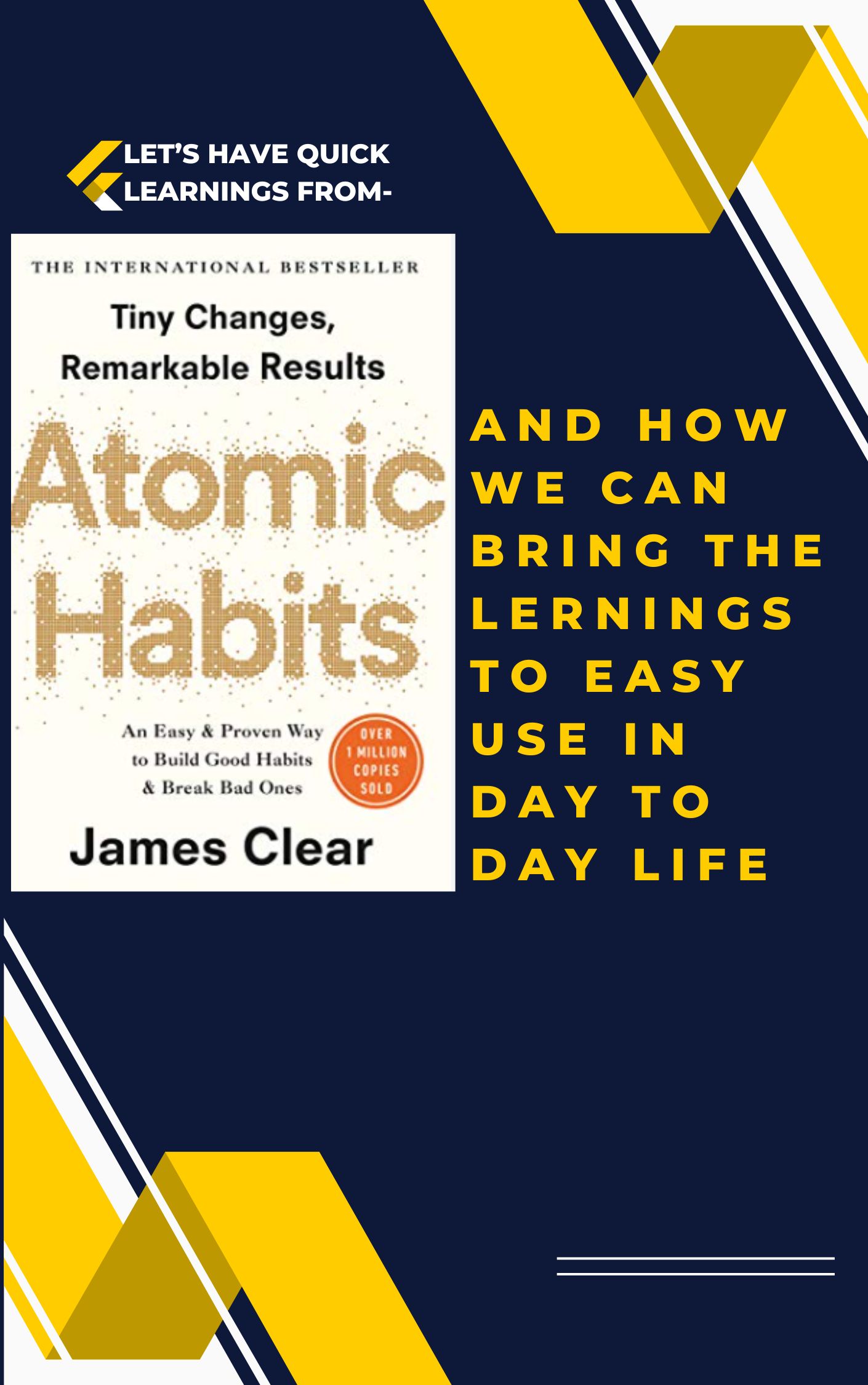
“Atomic Habits” by James Clear: A Comprehensive Summary
“Atomic Habits” by James Clear is a compelling exploration of the power of habits and how making small, consistent and small changes can lead to significant improvements in our lives over long term. Clear’s book is a guide to understanding the science behind the habits, breaking them down into manageable small elements and using them for personal and professional growth.
Overview:
James Clear introduces the concept of “atomic habits,” emphasizing the significance of small, incremental changes in behavior. He argues that habits are the compound interest of self-improvement, and by focusing on making tiny adjustments, individuals can achieve remarkable results over time.
The Four Laws of Behavior Change:
Clear establishes a framework for learning or unlearning a habit through four laws:
- Cue: The trigger that initiates a habit.
- Craving: The desire or motivation to perform the habit.
- Response: The behavior or action itself.
- Reward: The positive results, satisfaction or enjoyment that reinforces the habit.
Understanding these laws helps individuals identify and reshape their habits effectively.
In “Atomic Habits,” James Clear provides an example involving a smoker to illustrate the concepts of cue, craving, response, and reward in the habit loop. Here’s a breakdown of the smoker example from the book:
- Cue:
- The cue is the trigger or signal that initiates the habit loop. In the case of the smoker, it could be stress, boredom, or a specific time of day.
- Craving:
- The craving is the desire or motivation that follows the cue. For the smoker, this might be the craving for relief from stress, a desire for a break, or a need for stimulation.
- Response:
- The response is the actual behavior or action that addresses the craving. In this example, the smoker’s response is to light a cigarette.
- Reward:
- The reward is the positive outcome that reinforces the habit loop. Smoking provides immediate relief from stress, a break from routine, or a sense of relaxation for the smoker.
James Clear uses this example to illustrate that breaking a habit involves disrupting one or more elements of the habit loop. For instance:
- Changing the Cue: Instead of reaching for a cigarette in response to stress, the smoker could find alternative ways to cope, such as deep breathing, going for a walk, or engaging in a hobby.
- Altering the Craving: Finding alternative, healthier ways to satisfy the underlying desire or motivation, such as seeking social support, practicing mindfulness, or addressing the root cause of stress.
- Modifying the Response: Replacing the behavior with a positive alternative, such as chewing gum, drinking water, or engaging in a quick exercise routine.
- Adjusting the Reward: Identifying and adopting alternative rewards that satisfy the same craving, like enjoying a cup of tea, taking a brief break, or engaging in a pleasant activity.
By understanding and manipulating these elements of the habit loop, individuals can work towards breaking undesirable habits and building healthier, more positive ones. The smoker example serves as a tangible illustration of how habits function and how intentional changes to the habit loop can lead to successful habit transformation.
The Power of Habits:
Clear delves into the science of habits, emphasizing their impact on behavior and lifestyle. He discusses the habit loop, a neurological pattern that governs habitual behavior, and highlights the role of dopamine in reinforcing habits. By comprehending how habits function, individuals gain insight into reshaping their behaviors.
Identity-Based Habits:
Clear introduces the concept of identity-based habits, suggesting that lasting change occurs when individuals shift their focus from achieving a particular outcome to becoming the type of person who achieves that outcome. By aligning habits with a desired identity, individuals create a powerful internal motivation for change.
For illustration given in the book, in the above mentioned smoker case, if someone ask you to accompany him/ her for smoking you can deny in two ways-
- I am trying to give up smoking or I have given up smoking
- I am not a smoker or I don’t smoke (Identity based & more effective)
The Three Layers of Behavior Change:
Clear presents a model of behavior change comprising three layers: outcome change, process change, and identity change. He argues that the most effective and sustainable change occurs at the identity level, where habits are aligned with one’s self-perception.
How Habits Shape Identity:
The author explores the reciprocal relationship between habits and identity, emphasizing that habits not only reflect but also reinforce one’s sense of self. By intentionally adopting small habits that align with a desired identity, individuals can gradually reshape their self-image.
The Two-Minute Rule:
Clear introduces the two-minute rule, suggesting that any habit can be started by taking a small action that takes less than two minutes. This approach makes it easier to overcome inertia and build momentum for more significant changes.
Habit Stacking:
To facilitate habit formation, Clear introduces the concept of habit stacking, where new habits are anchored to existing routines. By associating new behaviors with established ones, individuals can seamlessly integrate positive changes into their daily lives.
Environment and Habit Formation:
Clear emphasizes the influence of environment on habits, noting that small changes in surroundings can significantly impact behavior. Optimizing one’s environment to support positive habits and discourage negative ones is a key aspect of successful habit formation.
For instance you may keep the water bottles at main locations in the house/ office if you want to increase water intake.
The Plateau of Latent Potential:
Clear introduces the concept of the plateau of latent potential, where the results of efforts may not be immediately visible. He stresses the importance of persistence during this phase, as small habits accumulate beneath the surface before breaking through to noticeable outcomes.
The Role of Identity in Behavior Change:
Clear explores the relationship between identity and behavior, arguing that habits are a reflection of one’s self-image. By focusing on building a positive identity and aligning habits with that identity, individuals can drive lasting behavior change.
Social Influences on Habits:
The author discusses the impact of social connections on habit formation. Surrounding oneself with a supportive community that shares similar goals and values enhances the likelihood of successful habit development.
The Goldilocks Rule:
Clear introduces the Goldilocks Rule, suggesting that habits are most effective when they are challenging enough to be meaningful but not so difficult as to be demotivating. Finding the right level of difficulty ensures ongoing engagement and progress.
The Cardinal Rule of Behavior Change:
The cardinal rule of behavior change, according to Clear, is to make it obvious, attractive, easy, and satisfying (the O.A.E.S. framework). By applying this framework, individuals can create an environment that fosters positive habits and minimizes resistance.
Conclusion:
“Atomic Habits” by James Clear is a comprehensive guide to understanding and harnessing the power of habits for personal and professional growth. Clear combines scientific insights with practical strategies, providing readers with a roadmap for making small changes that lead to significant improvements over time. By focusing on identity-based habits, leveraging the habit loop, and optimizing the environment, individuals can create a foundation for lasting positive change. The book emphasizes the transformative potential of tiny habits, making it a valuable resource for anyone seeking to cultivate a more fulfilling and successful life.
Practical Applications of the Book “Atomic Habits”
“Atomic Habits” by James Clear offers numerous practical applications that readers can apply to their daily lives to build positive habits and make lasting changes. Here are some key practical applications derived from the book:
- Start Small with the Two-Minute Rule:
- Identify your desired habits.
- Break them down into actions that take less than two minutes.
- Focus on consistently performing these small actions to build momentum.
- Habit Stacking:
- Identify existing habits or routines in your day.
- Stack new habits onto these established routines to create a seamless integration.
- This helps in associating the new habit with an existing, consistent behavior.
- Environment Design:
- Assess your environment for cues that trigger both positive and negative habits.
- Modify your surroundings to make positive habits more obvious and negative habits less appealing.
- This could involve rearranging your workspace, creating visual cues, or removing distractions.
- Identity-Based Habits:
- Define the type of person you want to become.
- Align your habits with this desired identity.
- This shift in mindset can provide a more profound and lasting motivation for habit change.
- Use the Goldilocks Rule:
- Evaluate the difficulty of your habits.
- Adjust them to be challenging enough to be meaningful but not so difficult that they become overwhelming.
- Find the right balance to ensure continued engagement and progress.
- Social Influences:
- Surround yourself with individuals who share similar goals and values.
- Share your goals with friends, family, or colleagues to create accountability.
- Leverage the positive influence of your social circle to reinforce good habits.
- Apply the O.A.E.S. Framework:
- Make habits Obvious: Clearly define your goals and set up visual cues.
- Make habits Attractive: Link positive habits to pleasurable experiences.
- Make habits Easy: Simplify the process of performing desired habits.
- Make habits Satisfying: Associate positive emotions with the completion of your habits.
- Track and Measure Progress:
- Keep a habit tracker to monitor your daily progress.
- Celebrate small victories to reinforce positive behavior.
- Regularly assess and adjust your approach based on what works and what doesn’t.
- Embrace the Plateau of Latent Potential:
- Understand that visible results may take time to manifest.
- Stay consistent during the plateau phase, trusting that your efforts are accumulating beneath the surface.
- Persevere through challenges and trust the process.
- Continuous Improvement:
- Develop a mindset of continuous improvement in all spheres of life.
- Reflect on your small habits on a regular basis and analyze their impact on your life both short term and long term.
- Adjust and refine your habits as your goals and circumstances evolve.
By incorporating these practical applications into your daily routine, you can harness the principles outlined in “Atomic Habits” to initiate positive changes in your life, both personally and professionally. The key is to focus on making small, consistent improvements over time, recognizing the compounding effect that these atomic habits can have on your overall well-being and success.
Other Must Reads:
Building Lasting Connections: A Deep Dive into “How to Win Friends and Influence People”
Quick Learnings from one of the Bestseller Self Help Book “The 7 Habits of Highly Effective People”
